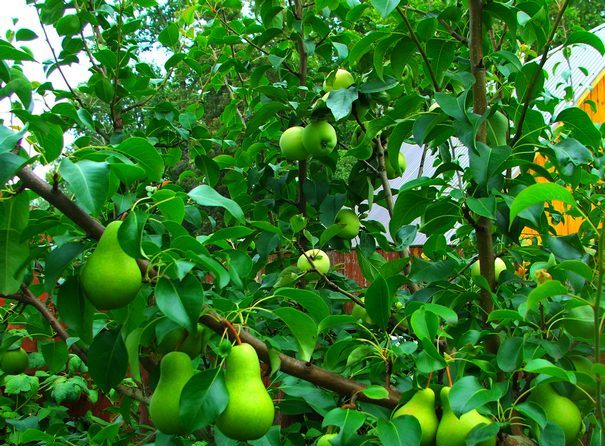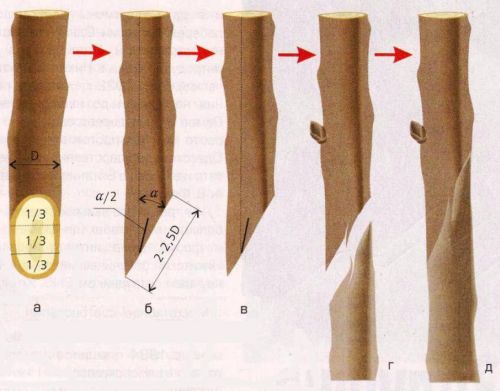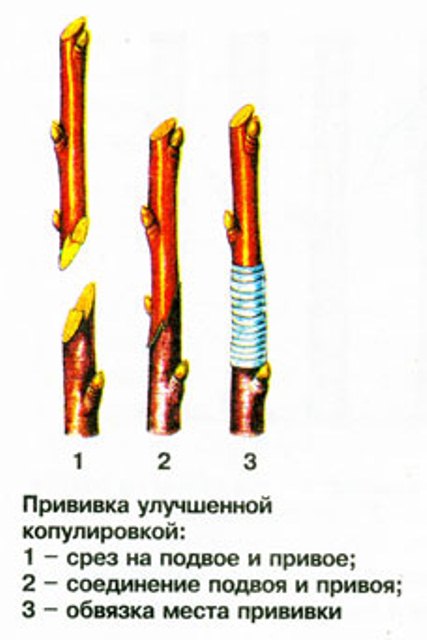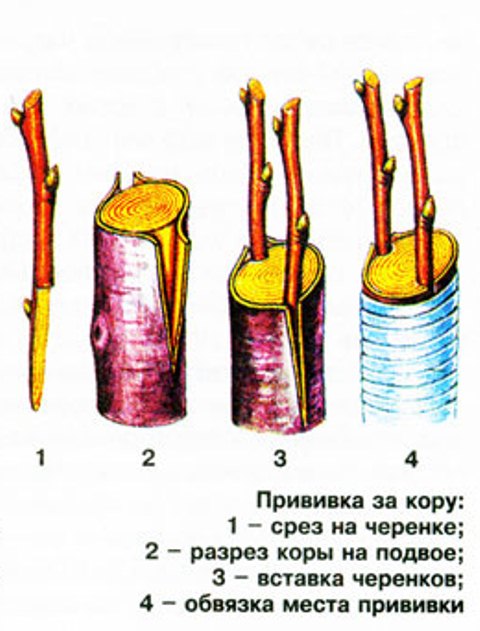High-quality harvest with the spring grafting of apple trees
Every gardener wants his garden to produce a high-quality and large-scale harvest. But it often happens that the apple tree does not produce few apples for a couple of years, or the fruits, in terms of taste, may not meet expectations. In this case, apple grafting will help. This will save time for planting and growing a new tree and will help expand the range of fruits your garden produces.
Content
Why do you need to plant apple trees?
To carry out this process correctly, you need to clearly know the purpose. vaccinations.
Grafting is one of the possible methods of vegetative propagation. In horticulture, this method is used to artificially merge parts of one plant with the shoot of another plant (in this case, different varieties and even other species can be used). In our case, the apple tree will act as a scion, and the stalk to be grafted will act as a rootstock.
Grafting makes it possible to graft on an apple tree, for example, a pear branch. As a result, you will get an apple tree with a branch that will yield pears. Consequently, several different fruits can be obtained from one tree at once.
In other cases, this operation is carried out in order to graft one or a couple of other varieties of apples to the tree or to obtain ornamental trees.
When carrying out this process in the spring, the following rules should be remembered:
- only related trees can be grafted. So, in our case, for example, a cultivated apple variety can be grafted into the wild. The following types of apple trees can be grafted: various cultivars on the wild forest apple (in this case, there will be a "wild" trunk with branches of the cultivated tree), as well as vegetative rootstocks (dwarf, semi-dwarf, medium-sized). In the case of re-grafting of an adult apple tree, it is possible to inoculate cuttings of other varieties of these fruit trees (if the fruitful function of these trees does not become obsolete);
- it should be remembered that the cambium layer of the stock must be in contact with the cambium of the scion to which the grafting is taking place. Otherwise, the stock will not take root.
Experienced gardeners also claim that grafting helps to rejuvenate the apple tree, and this will not only significantly extend the life of the tree, but will also help to get new tastes and new fruits on one tree.

Pros that spring grafting of an apple tree carries:
- helps to speed up the fruiting of the tree;
- there is an opportunity to get the fruits of a new variety;
- using this operation, you can change the natural appearance of the apple tree;
- the strength of the crown increases;
- if a part of the root is grafted, it is possible to obtain layering and increase the strength of cuttings of species and varieties of trees that, in their "wild" form, have a low rooting ability or do not take root at all;
- with the help of grafting, it is possible to stimulate the accelerated healing of various mechanical injuries on apple trees, which were caused by sunburn or various rodents. This property is based on the ability of the fruit tree to overgrow damage as a result of the increased activity of the cambium that has been exposed, as well as the nutrients contained in the rootstock and scion.
The most favorable time for spring vaccination is from mid-April to the end of May.
For adult apple trees that have healthy and intact branches, re-grafting can be done in the spring until the tree reaches 25 years. For younger apple trees, over 10 years old, this process should not be carried out immediately, but for a couple of years.In the first year, only half of the branches are re-grafted, and in the second year, the remaining half. Trees under 10 years old can be re-grafted once a year.
In order to carry out the vaccination without errors, you can first familiarize yourself with this process on video on the Internet.
Training
For the vaccination to go smoothly and correctly, you need to prepare for it.
To carry out this operation you will need:
- grafted material (stalk), which will be directly grafted to the apple tree;
- knife (preferably garden) with excellent sharpening;
- thin and sharp garden saw;
- garden putty (oil paint, varnish based on drying oil);
- the film that will be needed for strapping (best of all, polyethylene).
The cutting must be prepared from the very beginning of winter. It should be cut after the first frost. In this case, the branches will be in a dormant state. You can prepare the stock at the beginning of spring, but in this case you should make cutting stock until the kidneys swell.
For the stock, you need to choose annual shoots that grow on healthy and fruitful branches of the apple tree. The length of the harvested branch should be no more than 35 cm. In the cutting it is necessary to cut off the lower edge at an acute angle along an oblique line (the length of the cut should be three times larger than the diameter of the cutting), and leave the upper one "on the kidney". During the winter, cut twigs can be stored in the basement by placing the bottom of them in wet sand or sawdust. In the absence of a basement, cuttings (if small) can be stored in the refrigerator. In this case, they must be wrapped in a wet cloth.
A number of videos posted in the public domain on the Internet can also help to deal with this part of the process.
Two days before the scheduled vaccination, cuttings must be removed from the cellar or refrigerator and warmed up at room temperature.
At this stage, you also need to take care of the tools. They need to be taken out and prepared for work (cleaned and disinfected). The grafting knife must be well-sharpened so that the cuts are smooth and even. You also need to prepare a clean cloth for wiping the tools. When grafting several varieties of apple trees at once, it will not hurt to prepare the appropriate tags. They are usually made from strips of aluminum. For convenience, you can use a basin, box, etc., which will fit all the necessary tools.
Before proceeding with the direct vaccination, you should wash your hands very well with laundry soap. The tool with which this process will be carried out must also be washed well in order to avoid infection of the scion and rootstock. Do not touch the slices while inoculating.
All of the above tools and preparations will help you inoculating correctly and sterilely.
Vaccination methods
There are a wide variety of vaccine variations. The most commonly used methods are:
- simple copulation. This method is used when the diameters of the scion and rootstock are the same. Often, young, one- or two-year-old branches are grafted with this method. This method assumes the presence of identical cuts along the oblique line. This is done to completely match the cuts on the rootstock and the scion. When connecting, the sections must be kept pressed against each other for 60 seconds. If this is not done, then the surface of both cuts may have time to deteriorate (dry out and oxidize), which will lead to worse fusion and in the future may affect the fruiting of the tree;

- improved copulation. This method provides the most reliable coupling of the grafted part with the new base. Such a connection is possible due to the presence of a longitudinal additional cut on the cut or the so-called "tongue". A beveled cut is made along the axis on both parts and carefully cut by one third. Then the scion is carefully introduced into the stock.It is not necessary to inject the graft very deeply, otherwise you risk breaking off the vaccine or contributing to its suppuration. In the presence of a scion and rootstock with different diameters of branches, it is necessary to try very tightly to combine the cambium on one side so that the lumen is completely closed. A photo with this method of vaccination is shown below;

- cleavage inoculation. This method is great for branches with different diameters. It is necessary to split the stock crosswise or crosswise. As a result, a split is formed on the rootstock. Then you need to insert several cuttings into the resulting split. A long oblique cut is made on their lower part. Since in this method only one part of the grafted material will come into contact with the cambium, this procedure should be carried out very carefully and carefully.

- graft for the bark. This method involves the use of branches of large and medium diameter. This method can be used for inoculation during the period of sap flow, based on the "bark" method. In the place where the grafting will be carried out, it is necessary to carefully cut down the branch of the apple tree. But you need to keep the stump with a small bevel. Then you should well clean (for example, with a knife) the hemp cut. For a scion with one or two buds, you need to make an oblique cut in its lower part (opposite the lower bud). Do not forget to step back from the base of the bud by 5 cm when cutting. Then you need to cut and move the bark at the end of the stock with a knife. A scion is inserted into this cut with an oblique cut to the stock. If the branch has a diameter of more than five centimeters, you can graft two cuttings at once on both sides. Usually, this vaccination method is recommended for the very beginning gardeners, since it does not require very elaborate work. Also here the survival rate of branches is much higher than when using other methods. A photo with this method is shown below;

- lateral incision grafting. This method is used when it is not possible to inoculate for the bark. In this case, the handle is simply inserted into the side cut. To do this, you need to make an indirect cut through the wood and bark on the rootstock. At the same time, two longitudinal cuts should be made on the basis, which will be connected together. Then you need to carefully introduce the grafted material into the gap on the branch. It is necessary to exactly match the cambium and both parts. At the moment the cutting begins to grow, the upper part of the base must be cleaned with a knife. A photo of the final process of this vaccination method is shown below.

There are also less applicable methods of vaccination:
- grafting by cutting. It is used in the case of grafting an overgrown rootstock and, if necessary, grow a bonsai. Sometimes grafting is used to patch up damage on an apple tree. For this method, cuttings from one-year growth are used, leaving up to four buds on them. The diameters of the material to be grafted and the base must match. A long slanting cut is made on the rootstock. The stalk is cut with a pruner on one side, and on the other, a cut is made similar to the stock. Then you need to connect the stock and the scion;
- grafting in the form of a T-shaped incision. On the base you need to make an incision in the shape of the letter "T". The graft is inserted into this incision on the rootstocks;
- dormant eye or kidney vaccination. It is the easiest way and is suitable for amateurs. The survival rate of the kidneys is very high. Well suited for the wild.
Video "Spring grafting of apple trees"
With features grafting apple trees spring can be found in this video.
Conclusion - strapping and handling
The final stage of inoculation is strapping and processing of the site of cuts and introduction of the scion.
Most often, the site of inoculation is covered with garden varnish, and then all this is tied with electrical tape. It is best to use black duct tape.The black color will contribute to the heating of the cut sites and the introduction of the scion, which will lead to rapid overgrowth and restoration of the pathways in the tree. But some gardeners argue that it is better to use blue duct tape. since it is more noticeable and durable compared to other colors of electrical tape (it does not break at the time of strapping the vaccine). Instead of electrical tape, you can use elastic tape, which is made from polyethylene (you can use Teflon tape). The harness is used to fix the position of the grafted cuttings, as well as to quickly and correctly grow together. In the process of tying, you should not cover the cutting itself with a film, otherwise it may bloom prematurely.
To prevent infection of the vaccination site, as well as the penetration of pests into it, the strapping is treated with oil paint based on drying oil or drying oil itself.
Grafting is a necessary and beneficial measure as a stimulant for apple yields. It will help prolong the youthfulness of your fruit tree and make it possible to obtain different varieties of apples from the same tree.
